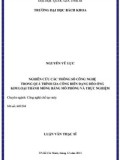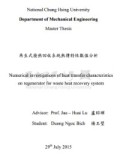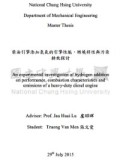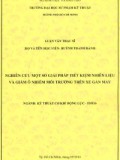


|
Tác giả: Nguyễn Vũ Lực. TS. Nguyễn Tường Long (người hướng dẫn). |
|
Đại học Bách Khoa TP. HCM. Năm: 2015. |
|
Mô tả: 96Tr. Kích thước: 30cm. Số định danh: 671 L552 |
|
Mục tiêu nghiên cứu: Tìm hiểu đặc trưng cơ học của kim loại trong bài toán biến dạng dẻo, bao gồm: * Sự thay đổi cấu trúc ống kim loại mỏng khi tiến hành uốn. * Ảnh hưởng của ma sát đến quá trình uốn. * Ảnh hưởng của góc uốn, bán kính uốn, kích thước hình học và tính chất vật liệu uốn. * Phương pháp giải bài toán biến dạng dẻo ống kim lọai thành mỏng bằng ANSYS/LSDYNA. |
|
Tác giả: Thi Trần Anh Tuấn. Professor Dong-Hau Kuo (người hướng dẫn) |
|
National Taiwan University of Science and Technology. Năm: 2015. |
|
Mô tả: 166Tr. Kích thước: 30cm. |
|
Abstract: High thermal conductivity, high electron mobility, high electron saturation velocity, and large band gap of nitride based materials have attracted many research interests in recent years. The GaN and InGaN materials have brought promising future for the application of electronic devices such as metal–oxide–semiconductor field effect transistors (MOSFETs), hetero junction field-effect transistors (HJ-FETs), Schottky diodes, p–n junction diodes, laser diodes, light emitting diodes (LEDs) etc. However, high-quality GaN, InGaN films and III-V nitride semiconductors for optoelectronic and electronic devices often have been grown on sapphire and several other semiconductor substrates by using metal organic chemical vapor deposition (MOCVD) and molecular beam epitaxy (MBE) above 800oC. The developments of III-V nitride materials and their devices made by using low-cost methods at low processing temperatures are very important in fabricating electronic devices. In this study, all diodes based on GaN and InGaN materials will be made at the low temperature with the cost-effective and reactive radio-frequency (RF) sputtering technique. The GaN and its alloy films were characterized by FE-SEM, EDS, XRD, TEM, AFM and Hall measurement at the room temperature. The electrical characterizations of diodes were determined by I–V and C–V measurements. The characteristics of our diodes can be successfully explained with the thermionic-emission (TE) model. Cheungs' and Norde methods were used to determine all electrical parameters of Schottky and p–n junction diodes. For the diode devices based on n–GaN and n–InGaN, the 500oC-annealed n–GaN MS (metal–semiconductor) and MOS (metal–oxide–semiconductor) Schottky diodes showed the smallest leakage currents of 1.02x10-8 and 1.86x10-9 A, respectively, at -1V. The highest SBHs for n–GaN MS and MOS Schottky diodes were calculated to be 0.79 and 0.81 eV , respectively, by the Cheungs’ method, and 0.91 and 0.94 eV by the Norde method. The n–GaN MOS diode showed a high series resistance of 84.4 kΩ, as compared to 27.9 kΩ for the n–GaN MS diode. In addition, n–InGaN MS and MOS Schottky diodes were studied before and after annealing at 400oC. The 400oC-annealed samples displayed the leakage current of 3.86x10-6 (MS) and 1.42x10-7 A (MOS). The SBH of n–InGaN MOS diode increased from 0.69 eV (I–V), 0.77 eV (Norde) to 0.82 eV (C–V) after annealing at 400oC. By C–V measurement for n–InGaN MOS diode, the carrier concentration was found to be 4.48x1017 cm-3 for the as-deposited and 2.41x1017 cm-3 for the annealed samples. The n–InGaN MOS diode had a small series resistance of 911 Ω, as compared to 84.4 kΩ for the n–GaN MOS diode. ........................................... |
|
Tác giả: Dương Ngọc Bích. Prof. Jau – Huai Lu (người hướng dẫn khoa học). |
|
National Chung Hsing University. Năm: 2015. |
|
Mô tả: 90Tr. Kích thước: 30cm. Số định danh: |
|
Abstract One of the excellent methods employed not only to recover waste heat from combustion furnaces is using regenerative heat exchanger that can help facilities significantly reduce fossil fuel consumption, as well as reduce associated operating costs, but also to control the Volatile Organic Compounds (VOCs) that consists of different kinds of chemical being adverse environment and health effects. The purpose of this study is to investigate the effects of operating and design parameters, two crucial variables in thermal performance of regenerative heat exchanger with two alternative working beds, on the efficiency of thermal exchange and the pressure drop through heating and cooling process. It is clearly that an extensive knowledge and thorough understanding of the heat transfer phenomena in the regenerator is essential. This study used numerical and analytical methods to simulate heat transfer process of regenerator brought out expected results for the temperatures of gases and solid material as function of time and space presented for the general asymmetric and unbalanced case. In particular, the thermal recovery efficiency is affected by the operating parameters as cycle duration (2% difference in each concerned semi-cycle duration), specific mass flow rate G (approximately 7% difference of the thermal effectiveness between G =1 and G =0.25 kg.m-2 .s-1 ). On the other hand, it is investigated that design parameters also influenced on regenerator performance such as ball size (thermal recovery efficiency is higher 97% for balls with diameter of 6mm and lower 95% for that of 15mm), bed height (about 2% disparity of thermal effectiveness of 0.8m, 1m, 1.5m, and 2m height of regenerator), bed void-age (about 4% disparity of thermal efficiency between 44% and 64% in porosity). These listed parameters also impact considerably to the pressure drop, namely the increase the ball size reduces the pressure drop whereas the decrease the specific mass flow rate enlarges the pressure drop of whole furnace. Moreover, comparison the capacity of thermal recovery of a uniform particle and that of a non-uniform particle as well as the similarity of thermal storage performance between the modified radius of non-uniform particle and the uniform are also illustrated in this paper. Last but not least, the comparison of real regenerator as a waste heat recovery device of real model (regenerative furnaces in a glass factory) to the simulation model for fixed bed will bring us the deep and clear overview to thermal distribution of regenerator about the thermal recovery efficiency. |
|
Tác giả: Trương Văn Mến. Prof. Jau Huai Lu (người hướng dẫn khoa học). |
|
National Chung Hsing University. Năm: 2015. |
|
Mô tả: 94Tr. Kích thước: 30cm. Số định danh: |
|
Abstract This research was conducted to investigate the effects of H2 addition, engine load, and diesel fuel flow rate on the brake thermal efficiency (BTE), incylinder pressure, heat release rate, exhaust temperature and exhaust emissions of Oxides of Nitrogen (NOx), Carbon Monoxide (CO), unburned Hydrocarbon (HC), Carbon Dioxide (CO2) and smoke. The engine load was varied from 25 to 100% with H2 concentration in the intake mixture (H2/(H2+Air), vol.) varied from 3 to 7% at engine speed 1650 RPM. The combustion analysis illustrated that the effect of the addition of H2 on combustion process depended on the load and the amount of H2 added. The addition of H2 at 25% load substantially deteriorated the premixed combustion but slightly enhanced and elongated the diffusion combustion. Conversely, the addition of H2 at 70% and 100% loads substantially increased the peak cylinder pressure, rate of pressure rise and peak heat release rate with slightly advance of phasing. In addition, adding hydrogen has small effect on the cyclic variation of combustion of H2-diesel mixtures in a diesel engine. For emissions, the addition of H2 shows that there was a slight reduction of the emissions of CO except for 100% engine load. Furthermore, the better combustion of hydrogen fuel and the absence of carbon atom in hydrogen molecule are the reasons leading to the decreases of CO2 emission and opacity. Especially, at 75% load, the change of CO2 emission was significant and the largest reduction of CO2 was obtained 32.3% with 7% H2 addition compared to neat diesel fuel. Although there was not different in HC emissions with and without H2 supplement they tended to decrease in H2-diesel dual fuel operation. In addition, the good effect H2 addition on PM was also found at 50% and 75% engine loads. The improvement to the BTE has been one of the main objectives of this engine research. Unfortunately, the addition of a relatively large amount of H2 (3- 7%) at different engine loads did not improve the BTE of the engine. At 25% load, the brake thermal efficiency reduced about 30% at 7% H2 enrichment while the values were 17.5%, 13.1% and 10.6% when engine loads were 50%, 75% and 100%, respectively, with the same amount of H2 addition. It is found that unburned H2 was main reason for reduction of BTE, obviously at low and medium loads. The measured exhaust temperature increased gradually at all tested engine loads. In particular, the exhaust temperature at 7% H2 added rose 7.4%, 10.4%, 11% and 12.3% when engine run at 25%, 50%, 75% and 100% of load, respectively. Besides, the higher temperature combustion caused increase of the NOx emissions for all cases of H2 addition. |
|
|
|
Tác giả: Huỳnh Thanh Bảnh. TS. Trần Thanh Thưởng (người hướng dẫn khoa học). |
|
Trường Đại học Sư phạm Kỹ thuật TP. HCM. Năm: 2015. Mô tả: 73Tr. Kích thước: 30cm. Số định danh: Minh, 2014. Vị trí: Phòng Tài nguyên nội sinh. |
 |
|
Mục đích, đối tượng và phạm vi nghiên cứu: Mục đích của đề tài: xây dựng cơ sở lý luận và thực tiễn tác động vào hệ thống điều khiển sạc accu trên xe gắn máy điện cho phép giảm chi phí nhiên liệu và ô nhiễm môi trường. Đối tượng nghiên cứu của đề tài là nghiên cứu khả năng lắp thêm động cơ và máy phát điện trên xe máy điện nguyên thủy để nạp điện bổ sung cho accu nhằm kéo dài quãng đường xe chạy. Trong phạm vi nghiên cứu của đề tài tác giả sẽ tiến hành các nhiệm vụ cụ thể sau: - Chọn xe máy điện nguyên thủy phục vụ cho việc nghiên cứu đảm bảo các yêu cầu về giá cả, kiểu dáng và đặc biệt là có đủ không gian để bố trí các thiết bị bổ sung phục vụ cho việc nghiên cứu. - Chọn động cơ kéo và máy phát điện phù hợp dùng để phát điện nạp bổ sung cho xe máy điện trong quá trình hoạt động. - Nghiên cứu tổng thành hệ thống điện trên xe gắn máy điện. - Chọn lựa giải pháp, thiết kế, chế tạo bộ nâng điện áp nguồn ba pha xoay chiều dạng xung 12v lên 48v (DC), nạp cho accu xe điện. - Thiết kế, chế tạo bộ dò dung lượng còn lại trên accu xe điện từ đó tự động điều khiển khởi động động cơ nhiệt kéo máy phát phát điện nạp bù cho accu và cấp năng lượng cho xe hoạt động, đồng thời nhận dạng và điều khiển tắt máy khi accu đã được nạp tương đối đầy điện. - Nghiên cứu vị trí lắp đặt động cơ, bộ phận phát điện, bộ nạp, bộ dò điện áp và đấu dây hệ thống. - Thực hiện lắp đặt tổng thành bộ nạp bổ sung và vận hành thử hệ thống. - Thực nghiệm đo quãng đường đi được từ lúc accu đầy điện đến khi accu hết điện hoàn toàn. - Thực nghiệm đo quãng đường đi được khi xe vận hành bằng động cơ nạp bổ sung / lượng nhiên liệu cố định. - Thực nghiệm đo kiểm mức độ phát thải ô nhiễm ra môi trường trên động cơ nhiệt. - Thực nghiệm so sánh tổng quãng đường đi được giữa động cơ nhiệt thuần túy và động cơ điện – nhiệt / cùng một lương nhiên liệu. - So sánh chi phí / km đối với từng loại hệ thống. |










